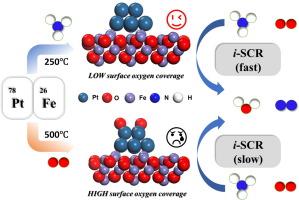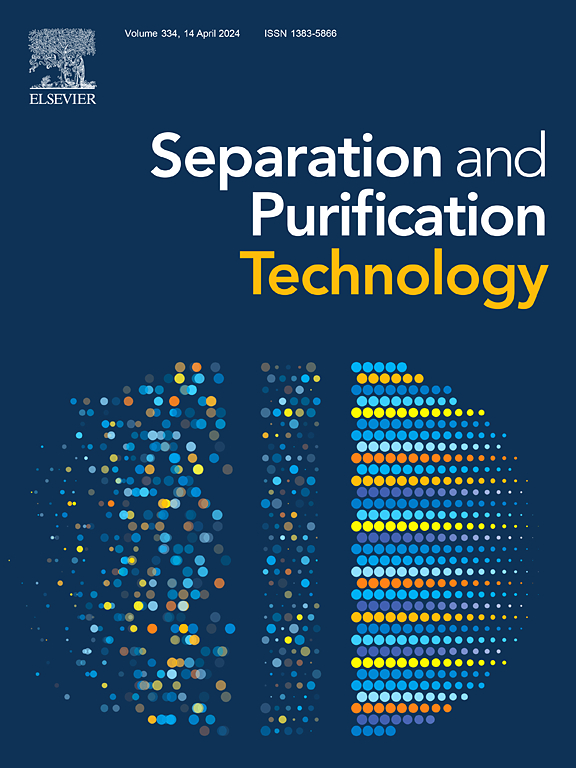In-situ gas-modulating electron structure of Pt to boost NH3-SCO reactions over Pt/Fe3O4
IF 8.1
1区 工程技术
Q1 ENGINEERING, CHEMICAL
引用次数: 0
Abstract
The selective catalytic oxidation of ammonia (NH3-SCO) over Pt-based catalysts is a promising method for reducing NH3 into N2 and H2O. Iron oxide, a typical and cheap redox carrier, can potentially affect the electronic or geometric structure of Pt sites. What’s more, the properties of Pt sites could be easily modulated through in-situ gas modulation. In this study, the Pt-supported Fe3O4 catalyst (PtFe) was subjected to modulation by reaction gases (21 % O2 or 0.4 % NH3) at varying temperatures (250 °C and 500 °C). Among all samples, the PtFe reduced at 250 °C (PtFe-N250) displayed the most favourable NH3-SCO performance, with 93.3 % NH3 oxidation and 65 % N2 selectivity achieved at 225 °C. The mechanism of the NH3-SCO over PtFe-N250 was investigated through a series of ex-situ characterizations and in-situ DRIFTS. The favourable NH3 oxidation performance observed over PtFe-N250 below 250 °C could be attributed to the high concentration of Pt0 species and high content of strong acid sites. The in-situ DRIFTS indicated that the NH3-SCO over PtFe-N250 followed the internal selective catalytic reduction (i-SCR). This study offered a novel strategy for enhancing the NH3-SCO performance of PtFe using in-situ gas-modulating approachs.

原位气体调节铂的电子结构,促进 Pt/Fe3O4 上的 NH3-SCO 反应
在铂基催化剂上进行氨(NH3-SCO)的选择性催化氧化是将 NH3 还原成 N2 和 H2O 的一种很有前景的方法。氧化铁作为一种典型而廉价的氧化还原载体,有可能影响铂位点的电子或几何结构。此外,通过原位气体调制,还可以轻松调节铂位点的性质。在本研究中,铂支撑的 Fe3O4 催化剂(PtFe)在不同温度(250 ℃ 和 500 ℃)下受到反应气体(21 % O2 或 0.4 % NH3)的调制。在所有样品中,在 250 °C 下还原的 PtFe(PtFe-N250)显示出最理想的 NH3-SCO 性能,在 225 °C 下实现了 93.3% 的 NH3 氧化和 65% 的 N2 选择性。通过一系列原位表征和原位 DRIFTS,研究了 PtFe-N250 上 NH3-SCO 的机理。在 PtFe-N250 上观察到的低于 250 °C 的良好 NH3 氧化性能可归因于高浓度的 Pt0 物种和高含量的强酸位点。原位 DRIFTS 表明,PtFe-N250 上的 NH3-SCO 氧化过程遵循了内部选择性催化还原(i-SCR)。这项研究为利用原位气体调节方法提高 PtFe 的 NH3-SCO 性能提供了一种新策略。
本文章由计算机程序翻译,如有差异,请以英文原文为准。
求助全文
约1分钟内获得全文
求助全文
来源期刊

Separation and Purification Technology
工程技术-工程:化工
CiteScore
14.00
自引率
12.80%
发文量
2347
审稿时长
43 days
期刊介绍:
Separation and Purification Technology is a premier journal committed to sharing innovative methods for separation and purification in chemical and environmental engineering, encompassing both homogeneous solutions and heterogeneous mixtures. Our scope includes the separation and/or purification of liquids, vapors, and gases, as well as carbon capture and separation techniques. However, it's important to note that methods solely intended for analytical purposes are not within the scope of the journal. Additionally, disciplines such as soil science, polymer science, and metallurgy fall outside the purview of Separation and Purification Technology. Join us in advancing the field of separation and purification methods for sustainable solutions in chemical and environmental engineering.
 求助内容:
求助内容: 应助结果提醒方式:
应助结果提醒方式:


